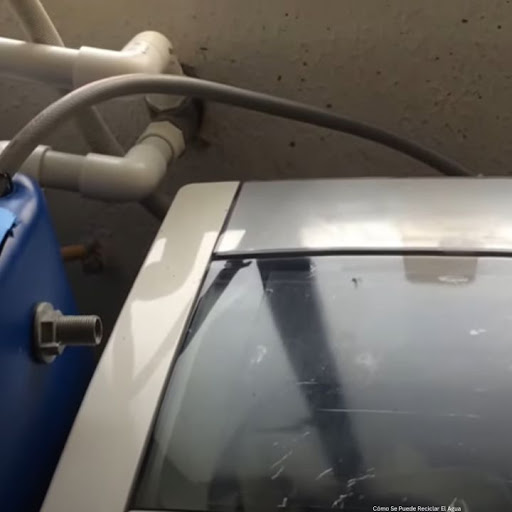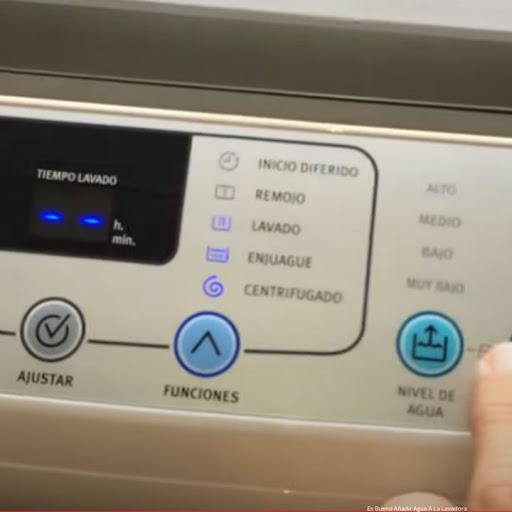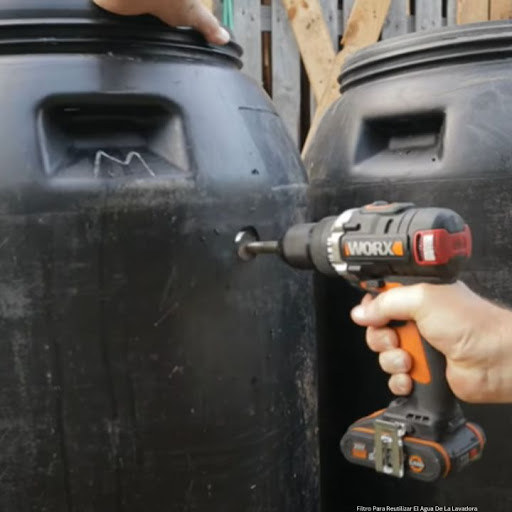How To Recycle Washing Machine Water
- Water Capture: The first thing to do is to install a system to capture water from the washing machine. You can do this by attaching a hose to the drain of the washing machine and directing it into a large container, such as a barrel or holding tank.
- Filtration: Once the water in the washing machine has been captured, it is advisable to filter to remove any solid residue or particles present. You can use a fine mesh filter or even a cloth to filter the water and prevent blockages in the reuse system.
- Storage: Once filtered, the water can be stored in a suitable container. It is important to use a tank or barrel with a lid to avoid the proliferation of insects or the accumulation of dirt in the water.
- Appropriate use: Recycled water from the washing machine can be used for various household activities that do not require potable water. Common uses include watering plants, cleaning floors or washing vehicles. Avoid using this water for activities involving direct contact with food or for filling swimming pools.
- Maintenance: It is important to carry out regular maintenance of the water recycling system of the washing machine. Clean the filters regularly and ensure that the storage is in good condition. If you notice any unpleasant odours or changes in the colour or appearance of the stored water, it is advisable to discard it and start again.


A filter to reuse Washing Machine Water is a useful tool that allows you to capture, filter and efficiently use the water used in the washing cycles. This device is particularly beneficial for saving water in the household and contributes to the protection of the environment.
Here we present information on filters for reusing washing machine water:
- Operation: A filter to reuse the water from the washing machine is installed in the machine’s drainage system. Its main function is to capture impurities present in the waste water from the washing machine, such as detergent residues, lint and fabric fibres.
- Filtración: Estos filtros están diseñados con diferentes mecanismos de filtración para garantizar la eliminación efectiva de las partículas no deseadas. Some models use a combination of fine screens and sedimentation systems to retain impurities, while others may use filter media such as activated carbon to improve the quality of the recycled water.
- Debris Retention: The washer water reuse filters are designed to retain solid debris and prevent it from clogging the reuse system. This prevents undesirable particles from reaching the stored water, improving its quality and reducing the need for frequent cleaning of the storage system.
- Maintenance: Regular maintenance of the filter is important to ensure its efficiency and to prolong its service life. This involves cleaning or replacing the filter parts according to the manufacturer’s instructions. In addition, it is advisable to check and clean the filter components periodically to avoid clogging and ensure proper water flow.
- Benefits: Using a filter to reuse washing machine water has multiple benefits. In addition to saving drinking water, it contributes to reducing the burden on wastewater treatment systems and reduces environmental impact. It can also help you save on your water bill in the long run, as you will be using recycled water for activities such as watering plants or cleaning your home.
Remember that the choice of the right filter will depend on the characteristics of your washing machine and the specific needs of your household. If you are interested in installing a filter to reuse washing machine water, consult a professional or research the options available on the market to find the filter that best suits your requirements.
Using filters to reuse washing machine water is a responsible and sustainable practice that will allow you to make the most of this vital resource. Contribute to the care of the environment and save water by using this technology in your home!

Recycling water from the washing machine to irrigate the garden is a smart and eco-friendly way to use this resource efficiently. By implementing this practice, you will not only be saving drinking water, but you will also be providing additional nutrients to your plants. From Pigra Engineering S. L. we present a guide on how to recycle the water from the washing machine to water the garden in an effective way:
- Water harvesting: The first thing to do is to install a water harvesting system for the washing machine. Connect a hose to the drain of the Washing Machine and run to a storage container, such as a barrel or tank. Make sure that the container has sufficient capacity to hold the amount of water that is discharged in each wash cycle.
- Use of suitable detergent: It is important to use detergents that are safe for plants and the environment. Opt for biodegradable detergents and avoid detergents containing harmful chemicals such as phosphates. This will ensure that the recycled water is safe for your plants.
- Filtration: Before using recycled water to irrigate the garden, it is advisable to filter it to remove any solid residue or particles present. You can use a fine mesh filter or even a cloth to ensure that the water is free of impurities that can clog irrigation systems.
- Proper storage: Once filtered, recycled water should be stored in a suitable container. Use a tank or barrel with a lid to prevent insects from proliferating or dirt from accumulating in the water. Make sure the container is tightly sealed to avoid unnecessary leakage or spillage.
- Garden watering: Use recycled water from the washing machine to water your garden. You can do this manually with a watering can or even connect a hose to the storage container to facilitate watering. Be sure to distribute the water evenly and avoid excessive puddling in specific areas.
- Additional considerations: It is important to note that the recycled Water from the Washer may contain traces of detergents and other chemicals. It is therefore advisable to avoid watering edible plants with this water and to limit its use to ornamental and landscape plants. Also, recycled water should not be stored for long periods of time, as it can become stagnant and unhealthy for plants.
Recycling washing machine water for watering the garden is a great way to reduce water consumption and make the most of this valuable resource. You will also be providing additional nutrients to your plants, which can help them to grow and develop. Contribute to the care of the environment and enjoy a beautiful and healthy garden by using this sustainable practice in your home!

Cleaning the Water from the Washing Machine is an important process to maintain the efficiency of the machine and to ensure that the water used in the washing cycles is in optimal condition. Here we present a guide on how to clean Washing Machine Water effectively:
- Filter cleaning: Most washing machines have a filter that helps trap lint and other solid residues that can accumulate in the water. It is advisable to check and clean this filter regularly to avoid clogging and to maintain proper water flow. Refer to your washing machine manual for the correct location and method of cleaning the filter.
- Drum disinfection: The washer drum can accumulate detergent residues, dirt and bacteria over time. To disinfect it, you can use a specific disinfectant for washing machines or a solution of hot water and white vinegar. Perform an empty wash cycle with the disinfectant or vinegar solution to clean and deodorise the drum.
- Cleaning the rubber seal: The rubber seal around the door of the washing machine can accumulate detergent residue, dirt and moisture, which can lead to mould and odours. Clean the rubber seal with a damp cloth and a little mild detergent to remove any dirt or mould present. Be sure to dry thoroughly after cleaning to prevent mould growth.
- Regular maintenance: In addition to cleaning the water in the washing machine, it is important to perform regular maintenance to ensure its proper functioning. Regularly clean the inside of the washing machine with a damp cloth, paying special attention to areas prone to residue build-up. Also, avoid overloading the machine and use the right amount of detergent to avoid residue build-up in the water.
- Use of suitable products: Use high quality detergents suitable for your type of washing machine. Avoid excessive use of detergent, as this can leave residues in the water and affect its quality. In addition, choose environmentally friendly products to reduce environmental impact.
Regular cleaning of the water in the washing machine is essential to maintain its performance and prolong its life. By following these steps, you can ensure that the water used in the wash cycles is clean and free of residues, thus contributing to efficient machine operation and optimal wash results.

Filtering Washing Machine Water for Irrigation Use is a smart and sustainable way to use this resource in your garden, which Pigra Engineering S. L. recommends. By filtering your water, you can remove impurities and debris that could clog irrigation systems and ensure a better quality water supply for your plants. Here is a guide on how to filter water from the Washing Machine for use in irrigation:
- Water capture: Connect a hose to the drain of the washing machine and direct the end to a storage container, such as a barrel or tank. Make sure that the container has sufficient capacity to hold the amount of water discharged in each wash cycle.
- Initial sedimentation: Allows the captured water to settle in the vessel for a period of time. This will allow heavier debris, such as sand and dirt, to settle to the bottom of the container.
- Primary filtration: Uses a fine mesh or sieve to filter the captured water before transferring it to a second storage vessel. This will help to remove larger particles and solid residues that may be present.
- Additional filtration: If you want a more advanced level of filtration, consider using an additional filter. You can use a sand filter, an activated carbon filter or even a commercial filtration system designed specifically for this purpose. These filters will help remove smaller particles and improve water quality for irrigation.
- Proper storage: Once filtered, the water should be transferred to a clean storage container. Use a tank or barrel with a lid to prevent insects from proliferating or dirt from accumulating in the water. Make sure the container is tightly sealed to avoid unnecessary leakage or spillage.
- Garden watering: Use the filtered water from the washing machine to water your garden. You can do this manually with a watering can or connect a hose to the storage container to facilitate watering. Be sure to distribute the water evenly and avoid excessive puddling in specific areas.
Remember that filtered water from the washing machine may contain traces of detergents and other chemicals. It is therefore advisable to avoid watering edible plants with this water and to limit its use to ornamental and landscape plants. In addition, it is important to regularly maintain the filters used to ensure their efficiency and prolong their service life.
By filtering the water from the washing machine for use in irrigation, you are making use of a valuable resource and helping to save drinking water. In addition, you will be reducing the burden on water supply and wastewater treatment systems. Enjoy a healthy and sustainable garden using this practice at home!

Recycling water at home is a sustainable and responsible practice that allows us to make the most of this valuable resource. By recycling water, we not only contribute to the care of the environment, but we can also save on our drinking water consumption. From Pigra Engineering S. L. we present a guide on how to recycle water at home in an effective way:
- Rainwater harvesting: A common way to recycle water at home is through rainwater harvesting. Installing a rainwater harvesting system is relatively simple. Place suitable barrels or containers at collection points, such as roof drains. The collected water can be used for watering plants, cleaning the outside of the house or even for household chores that do not require drinking water, such as washing floors.
- Reuse of Washing Machine Water: The water used in the washing machine’s wash cycles can be recycled for different purposes. Connect a hose to the drain of the washing machine and direct the water into a storage container. This water can be used for watering the garden, washing outdoor areas or even for household cleaning tasks that do not require drinking water.
- Collecting and reusing shower water: While you wait for the shower water to reach the desired temperature, you can collect the cold water in a bucket or pail. This water can be used for watering plants, cleaning floors or even flushing toilets.
- Efficient use of water in the household: In addition to recycling water, it is important to take measures for efficient water use in the household. Install water-saving devices on taps, showers and toilets, and be sure to repair any leaking or dripping pipes. Reducing shower time, turning off the tap while brushing teeth or washing dishes, and using only the necessary amount of water when cooking are simple but effective actions to reduce drinking water consumption.
- Treatment of recycled water: Depending on the use of the recycled water, additional treatment may be necessary to ensure its quality. For example, if you plan to use recycled water for irrigation in a vegetable garden, it is important to use adequate filtration and disinfection systems to ensure food safety.
Recycling water at home is an effective way to reduce drinking water consumption and care for the environment. Every small action counts, and by implementing these practices in your home, you will be contributing to the conservation of this valuable resource for future generations. Remember that every drop counts on the road to sustainability!

Collecting Water from the Washing Machine is an excellent way to use this resource at home in a sustainable way and save drinking water. Capturing the water from the washing machine allows us to use it for various tasks, such as watering plants, cleaning outside or even for use in toilets. Here is a guide on how to collect water from the washing machine effectively:
- Location of the collection container: The first thing you need to do is to identify a suitable container to collect the water from the washing machine. You can use a barrel, a tank or even a large bucket, depending on the amount of water you want to collect. Place the container near the washing machine, preferably under the drain.
- Hose connection: Most washing machines have a drain hose to allow used water to drain away. Connect an additional hose to the end of this drain hose and direct the other end into the collection container you have prepared. Make sure the hose is secure and well positioned to avoid spills or leaks.
- Adjusting the drain: Depending on the model of your washing machine, you may need to adjust the drain to ensure that water flows into the hose and collection basin. Refer to the Washer manual or find specific instructions for your model to make the necessary adjustments.
- Water flow control: During the wash cycle, be sure to monitor the flow of water into the collection basin. Make sure that the container is not overfilled and that no spillage occurs. If necessary, adjust the hose position or water flow to properly control the amount of water being collected.
- Water storage and reuse: Once you have collected the water from the Washer, transfer it to a suitable storage container. You can use barrels or tanks with lids to avoid contamination and insect proliferation. Clearly label the container to indicate that the water is not potable and use it for activities that do not require potable water, such as watering plants or outdoor cleaning.
Collecting the water from the washing machine is a simple and effective practice that allows us to use this resource in a responsible way. Not only are we saving drinking water, but we will also be reducing the burden on water supply systems. Remember that every drop counts and together we can make a difference in the conservation of this precious resource!

Reusing Water is an excellent way to promote sustainability and maximise the use of this valuable resource. Here are some creative ideas for reusing water in various areas of your daily life:
- Plant and garden watering: Water used for washing fruit and vegetables, water from the shower while heating up or water from the washing machine can be reused for watering plants and the garden. Just be sure to use water that is free of harmful chemicals, such as detergents or cleaners, especially if you plan to water edible plants.
- Just be sure to use water that is free of harmful chemicals, such as detergents or cleaners, especially if you plan to water edible plants. Fill a bucket with this water and use it to mop floors, clean surfaces or wash windows. You will avoid wasting drinking water and reduce your consumption.
- Toilet flushing: If you have an adequate plumbing system, you can reuse water from the washing machine, sink or shower to flush toilets. You can connect a hose to the corresponding drain and direct it towards the toilet tank to be used for each flush.
- Refilling pets: Water left in your pets’ containers, such as water bowls or drinking fountains, can be reused for watering plants or for other non-drinking purposes. Make sure that the water is not contaminated and does not contain chemicals harmful to plants.
- Vehicle cleaning: Use reused water to wash your vehicles. You can collect rainwater in a barrel and use it for this purpose. If you use tap water, be sure to use a bucket rather than a hose, as this helps to minimise consumption.
- Filling pools or ponds: If you have a pool or pond on your property, consider using reused water to fill it. Rainwater collected in barrels or wastewater from other domestic activities may be suitable options for reducing potable water use.
Remember that in all cases it is important to use common sense and make sure that the water you are using is not contaminated and does not contain harmful chemicals. In addition, it is essential to maintain a proper balance so as not to compromise hygiene and health in the water reuse process.
By reusing water in a creative way, you will be contributing to the care of the environment and the responsible use of natural resources. Every little effort counts and can make a difference to water conservation on our planet!

Recycling shower water for use in irrigation is an excellent way to harness this resource and promote sustainability in the home. By recycling your shower water, you are not only saving drinking water, but you are also reducing your consumption and helping to protect the environment. Here is a guide on how to recycle shower water for use in irrigation:
- Capturing the water: During the time it takes for the shower water to reach the desired temperature, you can capture the cold water in a bucket or pail. Place the bucket on the shower floor or under the tap to collect the water that would normally be wasted.
- Use of a reuse bucket: A practical option is to use a specially designed reuse bucket to collect and store shower water. These buckets are equipped with a lid and a hose connection, which facilitates the transfer and distribution of the recycled water.
- Water filtration: If the shower water contains residues such as hair, soap or dirt, it is advisable to filter it before using it for irrigation. You can do this by using a fine mesh filter or even a piece of cloth to trap larger particles.
- Proper storage: Transfer recycled water to a suitable storage container, such as a barrel or tank. Make sure the container is clean and tightly closed to avoid insect breeding or contamination of the water.
- Garden watering: Use recycled shower water to water your garden. You can do this manually using a watering can or by connecting a hose to the storage container to facilitate watering. Be sure to distribute the water evenly and avoid excessive puddling in specific areas.
- Responsible water use: It is important to remember that recycled shower water may contain small amounts of personal hygiene products such as soap or shampoo. Therefore, it is advisable to limit its use in the irrigation of edible plants and to use it mainly for ornamental or landscape plants.
Recycling shower water for use in irrigation is an effective way to reduce drinking water consumption and make the most of the resources available in your home. In addition, by recycling water, you will be promoting environmental awareness and contributing to water conservation. Every drop counts and together we can make a difference in the preservation of our planet!



Glossary:
- How To Recycle Washing Machine Water
- Washing Machine Water Reuse Filter
- How to Recycle Washing Machine Water for Garden Watering
- Cleaning Washing Machine Water
- Filtering Water Washing Machine for Irrigation
- How to Collect Water from the Washing Machine
- Ideas for Reusing Water
- How to Recycle Shower Water for Irrigation
- Can be watered with washing machine water
- It is good to add water to the washing machine
- Water Recycling Inventions
- How Water Can Be Recycled
